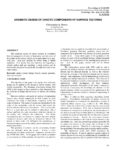
|
Axiomatic Design of Chaotic Components of Surface Textures
Brown C.
1st International Conference on Axiomatic Design, 2000
The axiomatic design of surface textures is considered from the perspective of scales of interaction and the scales of the texture on the surface, which can be represented in an areascale plot. Area-scale analysis by virtual tiling is briefly explained. It is shown how two functions one requiring a smooth surface and one requiring a rough surface can be functionally integrated but physically decoupled by scale on the same surface.
|
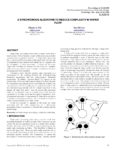
|
A Synchronous Algorithm to Reduce Complexity in Wafer Flow
Oh H. L., Lee T
1st International Conference on Axiomatic Design, 2000
Single-wafer processing yields better on-wafer result than a batch process. This is because a single-wafer processing provides superior process parameter control. A single-wafer processing has to rely on parallel processing at high speed with extensive use of redundant process modules and transporters to compete with the throughput of batch processing. A cluster of the many single-wafer modules and transporters may result in a complex wafer movement, which requires complex coordination of wafer processing and wafer transport. This paper shows that the complex wafer movement is a consequence of the coupling between the wafer-porcessing functional requirement and the wafer-transport functional requirement. By adding “planned delays”, i.e., queues, to the process time of the non-critical process steps, it is shown that the two functional requirements can be successfully de-coupled. The consequences of the de-coupling are (1) a synchronization of the two functional requirements and (2) a drastic reduction in the number of wafer flow paths. Item (1) ensures that processed wafers are transported always in a timely manner and, thus, the consistency in on-wafer result and throughput is improved. Item (2) minimizes the need of orchestration of wafer flow, and allows a consistent wafer process history. The end result is a reduced wafer-to-wafer variation in on-wafer result. A real life example of queuing to de-couple the wafer processing and the wafer transporting in a photo-resist processing system is presented to illustrate the concept and the methodology.
|
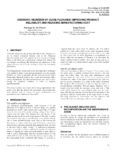
|
Axiomatic Redesign of Guide Flexures: Improving Product Reliability and Reducing Manufacturing Cost
del Puerto S. E., Garcia J.
1st International Conference on Axiomatic Design, 2000
Axiomatic design was the guiding principle in the redesign of a set of motion constraint flexures used in the Micrascan photolithography tool. The original flexures experienced fatigue failure in the field and a replacement solution with infinite life was desired. In addition, the fabrication and inspection of the original flexures was difficult, resulting in high cost and quality fluctuations. The Independence Axiom and system decomposition techniques were applied to derive functional requirements from the existing hardware, in order to guarantee that the redesign would yield a functionally identical solution that would not adversely affect system performance. The Information Axiom was used to select among the proposed solutions in order to improve manufacturability. The chosen solution was tested and is being implemented. Test results show that the desired life expectancy improvement has been obtained with no impact on system performance and procurement cost reduction of about 60%.
|
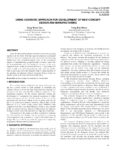
|
Using Axiomatic Approach For Development of New Using Axiomatic Approach For Development of New Concept Design and Manufacturing
Cha, S. W., Moon, Y. R.
1st International Conference on Axiomatic Design, 2000
Since the industrial revolution, industries have been growing rapidly in all the fields. With the rapid development economical efficiency has been emphasized, and economical manufacturing method has been researched abroad. One of the economical aspects of manufacturing is satisfying the customer’s need with the least production cost. The design of a product is the most important factor in the economical efficiency. A bad design will result in high cost and long production time with low quality. Such result comes from the designer’s lack of understanding of the product and subjective design decisions. Design errors are usually occurs in the materialization of the ideas.
|
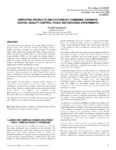
|
Improving Products and Systems By Combining Axiomatic Design, Quality Control-Tools and Designed Experiments
Engelhardt, F.
1st International Conference on Axiomatic Design, 2000
This paper presents an approach for solving design problems. A design analysis with Axiomaitc Design, called Design Object Analysis, describes a product or a system in terms of customer needs (CNs), functional requirements (FRs), design parameters (DPs), and process variables (PVs), as well as their associated design matrices (DMs). In this paper the design analysis is combined with a thorough investigation of possible problems within the design, utilizing the seven quality tools, noise factor analysis, and designed experiments to form an approach for quality improvements and problem solving.
|

|
Axiomatic Design of the Injection Molding Process
Kazmer, D. O.
1st International Conference on Axiomatic Design, 2000
Injection molded components are consistently designed to minimize the design and manufacturing information content of the enterprise system. The resulting designs, however, are extremely complex and frequently exhibit coupling between multiple quality attributes. Axiomatic design principles were applied to the injection molding process to add control parameters that enable the spatial and dynamic decoupling of multiple quality attributes in the molded part. There are three major benefits of the process redesign effort. First, closed loop pressure control has enabled tight coupling between the mass and momentum equations. This tight coupling allows the direct input and controllability of the melt pressure. Second, the use of multiple melt actuators provides for the decoupling of melt pressures between different locations in the mold cavity. Such decoupling can then be used to maintain functional independence of multiple quality attributes. Third, the heat equation has been decoupled from the mass and momentum equations. This allows the mold to be filled under isothermal conditions. Once the cavity(ies) are completely full and attain the desired packing pressure, then the cooling is allowed to progress.
|
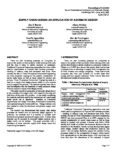
|
Supply Chain Design: An Application of Axiomatic Design
Baxter, J. E., Agouridas, V., McKay, A., de Pennington, A.
2nd International Conference on Axiomatic Design, 2002
There are ever increasing pressures on companies to improve the quality of their products whilst reducing both costs and the time it takes to deliver products to customers.Traditional Concurrent Engineering approaches have been widely used by organizations to improve their business processes -resulting in reduced costs and shortened lead times. More recently, the idea of Three Dimensional Concurrent Engineering has been proposed: arguing for the parallel consideration of supply chain issues as well as those related to product and process. Three Dimensional Concurrent Engineering leads to a need for a supply chain design process which, in turn, requires tools to support the process. The research reported here was an early investigation into the feasibility of using axiomatic design theory to support a supply chain design process.
|
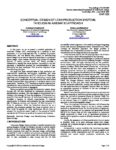
|
Conceptual Design of Lean Production Systems Through An Axiomatic Design Approach
Houshmand, M., Jamshidnezhad, B.
2nd International Conference on Axiomatic Design, 2002
In this paper, we are to present a practical application of Axiomatic Design (AD) methodology as a roadmap to lean production, in a car body assembly line. In addition to product development, AD has already been applied for manufacturing system design but we tend to expand its application to production system design, which besides manufacturing includes all activities required to satisfy customer needs. AD theory provides a framework to simplify the whole problem. According to the AD principles, a hierarchical structure for conceptualization of lean philosophy has been developed. This structure originates in lean manufacturing principles.
|
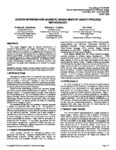
|
System Definition for Axiomatic Design Aided by Object-Process Methodology
oderborg, N., Crawley, E. F., Dori, D.
2nd International Conference on Axiomatic Design, 2002
This paper suggests ways to improve formulation of Functional Requirements and Design Parameters in Axiomatic Design based on the contention that adequate descriptions of both function (WHAT) and architecture (HOW) require a combination of objects and processes. We describe how the definitional framework and expressive power of Object-Process Methodology can be used to represent system function and architecture. We introduce Object-Process Methodology templates for describing function and architecture, and apply these templates as an example to a simple system.
|

|
Axiomatic Design of a Wing Driving Mechanism for Micro Air Vehicle with Flapping Motion
Park, Ji Hyung, Lee, K. R., Kim, K. H.
3rd International Conference on Axiomatic Design, 2004
Recently Micro Air Vehicles (MAVs) imitating the mechanism of birds or insects have been developed. As hummingbirds’ characteristics are regarded as an appropriate candidate for MAV model, the studies of hummingbirds’ aerodynamics and mechanics in relation to MAV are conducted. In this paper, an axiomatic design approach to develop a wing driving mechanism for MAV mimicking hummingbirds is proposed. Functional requirements (FRs) for the mechanism are defined through the analysis of the hummingbirds’ wing motions involving hovering, forward, and backward flight. Five FRs are introduced at the highest level. Constraints (Cs) in size and weight are taken from the limitation employed in the Defense Advanced Research Projects Agency’s MAV program. Design parameters (DPs) are conceived in physical domain to satisfy these specified FRs and Cs. Through the process of mapping and zigzagging to decompose to the next level, totally fifteen FRs and the same number of DPs are defined. The wing driving mechanism design is proved to be decoupled by design equation. Also we can reduce the complexity of the mechanism by physical integration.
|
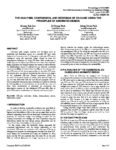
|
The Analysis, Comparison, and Redesign of CD-case Using the Principles of Axiomatic Design
Lee, K. W., Ji-Hyung Park, Jahng-Hyon Park
3rd International Conference on Axiomatic Design, 2004
CD-cases with various capacity and functions such as portability and individual access to a specific CD have been designed and manufactured. In this paper, a cake-type CD-case is redesigned using the axiomatic design theory to have the advantageous functions of other CD-cases. First, a cake-type, a wallet-type, and a cabinet-type CD-case are analyzed by axiomatic design approach and design matrices are made to check whether the independence axiom is satisfied or not. Second, functional requirements (FRs) are derived from the FRs of the existing caketype CD-case and the advantageous FRs of the other CD-cases. Constraints (Cs) are defined considering the volume and weight of the improved CD-case. Design parameters (DPs) are conceived in physical domain to satisfy these specified FRs and Cs, and two alternative DPs for one FR are proposed. One of these alternatives having the least information content is selected by defining FRs as the minimization of the production cost and time. Also marketability is estimated by comparing the information content of the redesigned CD-case with that of other CD-cases in consideration of capacity, volume, and price.
|
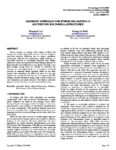
|
Axiomatic Approach for Stress Relaxation in Automotive Multi-shell-structures
Lee, Hyungyil, Gyung-Jin Park
3rd International Conference on Axiomatic Design, 2004
Recent attempt to enhance safety against collision has reshaped the simple single-shell structure into the integrated multi-shell structure. Moreover, due to various regulations continuously tightened for environment, weight reduction of automobile becomes an increasingly important issue. Weight reduction is mainly accomplished by better redesign, adoption of lighter materials, and small-sizing of auto (parts). Focusing on the local redesign among three, we attempt to determine the thickness of each subpart-shell of an integrated multi-shell structure by axiomatic design approach. Based on the finite element stress calculations, we relieve the stress of a box type subframe by varying the thickness of each subpart-shell. The redesign method successfully brings both a preset amount of stress relaxation and weight reduction. This kind of axiomatic approach can be extended to the other multi-shell structures.
|
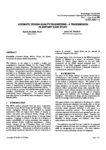
|
Axiomatic Design Quality Engineering – a Transmission Planetary Case Study
El-Haik, B., Wasiloff, J. M.
3rd International Conference on Axiomatic Design, 2004
The objective of this paper is to present a simple and comprehensive integrated Design for Six Sigma (DFSS) approach to design robustness. The approach is hinged on conceptual components for axiomatic design, robust design and Six Sigma. An automatic transmission planetary case study is provided as an illustration vehicle. Specifically, this paper will explore the cascading process of functional requirements to design parameters and features while providing an initial robustness assessment against the common sources of variation. A Six Sigma design quality level is pursued as an objective. The approach presented in this paper represents a stream of development to achieve excellence by improving customer satisfaction through quality enhancement efforts. It can be viewed as a process with detailed steps needed to cast a complete understanding of how to achieve desired breakthrough design improvement. The method presented here relies heavily on the DFSS theory developed by Yang and El-Haik (2003).
|
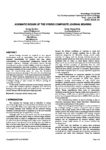
|
Axiomatic Design of the Hybrid Composite Journal Bearing
Kim, S. S., Park, D. C., Lee, D. G.
3rd International Conference on Axiomatic Design, 2004
Journal bearing materials are required to have special characteristics such as compatibility with journal interface materials, embeddability for particles and wear debris, conformability to accommodate misalignment, thermal and corrosion resistance. Although conventional journal bearing materials such as white metals or babbitt metals meet almost the required characteristics, they have possibility of seizure between the bearing material and the journal when the oil film is broken. From the manufacturing point of view, the functional requirements of journal bearing are “to reduce the manufacturing cost with easy processes,” “to be easily repaired and maintained,” and etc. These functional requirements are not easy to satisfy simultaneously with conventional manufacturing methods such as centrifugal casting of white metals and filament winding of composite materials. In this study, a hybrid composite journal bearing composed of carbon fiber reinforced phenolic composite liner and metal backing was developed to solve the problem of the conventional journal bearings with the axiomatic design approach.
|
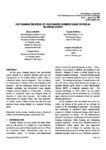
|
On Foaming Process of Vulcanized Rubber Using Physical Blowing Agent
Shimbo, M., Nomura, T., Muratani, K., Fukumura, K.
3rd International Conference on Axiomatic Design, 2004
In this paper, foaming process used supercritical carbon dioxide as a physical blowing agent and the characteristics of the foamed silicone rubber, which is vulcanized rubber, were investigated. First, the degree of vulcanization of silicone rubber was evaluated by the plasticity. And the relationship between plasticity and foaming conditions was investigated using samples changed variously degrees of vulcanization. Foaming process of vulcanized rubber was designed based on plasticity of rubber and discussed. And besides, the characteristics of foamed rubber were also measured. As results, foamed rubbers having fine cell size were produced using carbon dioxide as a physical blowing agent.
|
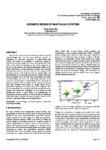
|
Axiomatic Design of Multi-scale Systems
Kim, S. G.
3rd International Conference on Axiomatic Design, 2004
Many of the current research activities are directed towards nanotechnology. The use of nano products requires an integration of nano-scale structures to macro/micro-scale systems. The degree of complexity of multi-scale systems is expected to increase rapidly as the scale order grows. The scale order can be defined in this paper as the relative magnitude of the size of the system to the smallest characteristic length of the system. Production of next generation IC chips and upcoming nanoproducts will have the scale order of 9 or above, which obviously will be a hard challenge with the existing design and manufacturing tools. Axiomatic approach for systems design has been an effective tool to provide new functionalities and better manufacturability of many new engineering products, and is expected to provide better understanding of the complexity of multi-scale systems. The causalities of the systems complexity have been reviewed with respect to design axioms and a hypothetical complexity reduction approach is proposed. The scale decomposition of a multi-scale system into small-scale order domains will reduce the complexity of the system and will subsequently ensure a good design and manufacturing by developing functional periodicity. A novel method of assembling individual carbon nanotube has been developed based on the concept of axiomatic design and complexity theory.
|
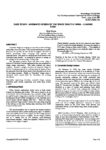
|
Case Study: Axiomatic Design of the Space Shuttle Wing – Leading Edge
Otero, R.
3rd International Conference on Axiomatic Design, 2004
Axiomatic design is emerging as a superior method of design, particularly when innovation versus incremental design is needed. However, the quantity of case studies to support education is limited, particularly those involving large systems and subcomponents. This paper is a teaching case study based on the Columbia Space Shuttle. In particular, it focuses on setting up the redesign of the shuttle’s wing – leading edge.
|
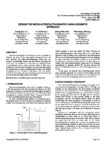
|
Design for Micro-stereolithography Using Axiomatic Approach
Lee., S. J., Lee, I. H., Cho, D. W., Hwang, W.
3rd International Conference on Axiomatic Design, 2004
Micro-stereolithography technology has made it possible to fabricate any form of three-dimensional microstructures. Until now, however, the micro-stereolithography device was not designed systematically because the key factors governing the device were not considered. In this paper, we designed microstereolithography device using axiomatic approach. This paper contains an overview and an analysis of a new proposed system for development of micro-stereolithography device, and detailed descriptions of the activities in this system. The new system offers reduced machine size by minimizing of optical components, and shows that the design matrix is decoupled.
|

|
Design Improvement in a Micro-gripper System By Axiomatic Approach
Jonghyup, J., Moon, W., Park, J.
3rd International Conference on Axiomatic Design, 2004
The micro-gripper system is one of the systems that should be improved in the respect of performance for practical usage. In the previous works, the important issues are considered and presented using axiomatic design approach. In this paper, the functional requirements and design parameters are evaluated in order to improve the performance and efficiency of the system. The evaluation is a very difficult task since many variables are related to the outcomes. To provide a basis for correct design decisions, axiomatic design principles have been advanced. Since the framework of axiomatic design makes design issues easier to understand when they are analyzed, we used those as an evaluation tool.
|
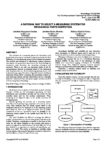
|
A Rational Way to Select a Measuring System For Mechanical Parts Inspection
Gonçalves-Coelho, A., Mourão, A. F., Navas, H. G.
3rd International Conference on Axiomatic Design, 2004
The selection of a measuring system for dimensional and geometrical tolerances of mechanical parts is crucial for the final definition of a manufacturing process and its detailed programme. The symbols and indications of adjustments, surface roughness, dimensional and geometrical tolerances in the final drawings of mechanical parts determine the measuring techniques and resources. There is not only one measuring system at all. Its appropriateness depends on particular details of the mechanical part, its production rate, its manufacturing process, human and technical means, costs, time limit, and specific contract conditions. Axiomatic Design allows comparing the information content of each measuring scheme, and this methodology can be a scientific basis for a rational selection. The present paper contains a studied real case using this methodology.
|
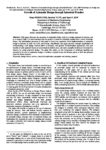
|
Growth of Axiomatic Design through Industrial Practice
Nordlund M., Tate D., Suh N.P.
Tech Papers
3rd CIRP Workshop on Design and the Implementation of Intelligent Manufacturing Systems, Tokyo, Japan, pp. 77-84, June 19-21, 1996.
This paper discusses the advances of axiomatic design, both as a design approach in industry and as a research field. It is demonstrated that the growth is based on industrial practice and a vision of design theory. The information presented in this paper is based on experience from implementation of axiomatic design in industry in Asia, the USA, and Europe. Specifically, this paper presents strategic implications of implementing a new design method within a company, two generic implementation approaches, risks and benefits of each approach based on actual implementation cases, and some examples of products developed by industry by using axiomatic design. The paper also points out the importance of continued teaching and research in the area of axiomatic design. It outlines a typical course for industry given at MIT and presents issues for future research.
|
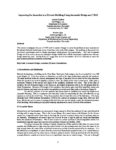
|
Improving the Acoustics in a Historic Building Using Axiomatic Design and TRIZ
Kankey, Andrew and Madara Ogot
Tech Papers
Pennsylvania State University
This article investigates the use of TRIZ and Axiomatic Design to solve the problem of poor acoustics in the historic Schwab Auditorium on the Penn State University Park campus. The problem is dissected to its functional requirements and the design parameters which govern the requirements. TRIZ and Axiomatic Design are then used to create an uncoupled design which solves all the functional requirements with one design parameter each. Finally there is a suggestion on how to combine all of the solutions to solve the poor acoustic problem in Schwab Auditorium.
|
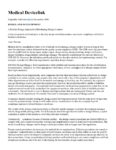
|
A Product Design Approach to Developing Design Controls
Worona, Taras
Tech Papers
Medical Device and Diagnostic Industry, November 2006
Using recognized methodologies to develop design control procedures can ensure compliance and lead to business excellence.
|